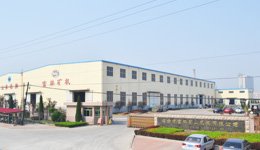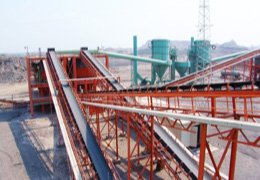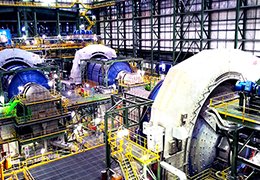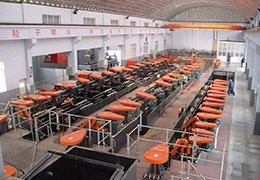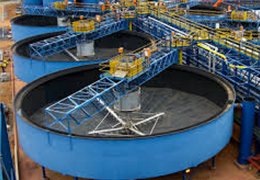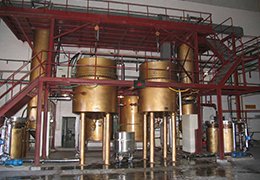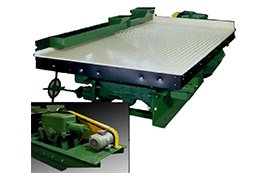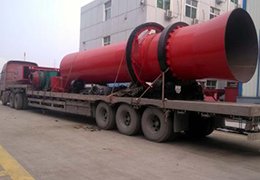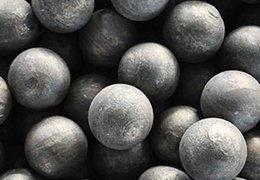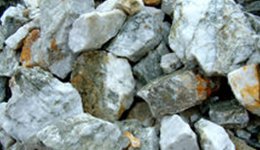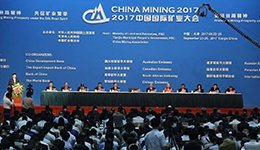Principle of operation[edit]
Before froth flotation can work, the ore to be treated is reduced to fine particles by crushing and grinding (a process known as comminution) so that the various minerals exist as physically separate grains. This process is known as liberation. The particle sizes are typically less than 0.1 mm (100 µm), but sometimes sizes smaller than 7–10 µm are required.[20] There is a tendency for the liberation size of the minerals to decrease over time as the ore bodies with coarse mineral grains that can be separated at larger sizes are depleted and replaced by ore bodies that were formerly considered too difficult.
In the mining industry, the plants where flotation is undertaken to concentrate ore are generally known as concentrators or mills.
For froth flotation, the ground ore is mixed with water to form a slurry and the desired mineral is rendered hydrophobic by the addition of a surfactant or collector chemical (although some mineral surfaces are naturally hydrophobic,[21] requiring little or no addition of collector). The particular chemical depends on the nature of the mineral to be recovered and, perhaps, the natures of those that are not wanted. As an example, sodium ethyl xanthate may be added as a collector in the selective flotation of galena (lead sulfide) to separate it from sphalerite (zinc sulfide). This slurry (more properly called the pulp) of hydrophobic particles and hydrophilic particles is then introduced to tanks known as flotation cells that are aerated to produce bubbles. The hydrophobic particles attach to the air bubbles, which rise to the surface, forming a froth. The froth is removed from the cell, producing a concentrate ("con") of the target mineral.
Frothing agents, known as frothers, may be introduced to the pulp to promote the formation of a stable froth on top of the flotation cell.
The minerals that do not float into the froth are referred to as the flotation tailings or flotation tails. These tailings may also be subjected to further stages of flotation to recover the valuable particles that did not float the first time. This is known as scavenging. The final tailings after scavenging are normally pumped for disposal as mine fill or to tailings disposal facilities for long-term storage.
Froth flotation efficiency is determined by a series of probabilities: those of particle–bubble contact, particle–bubble attachment, transport between the pulp and the froth, and froth collection into the product launder.[22] In a conventional mechanically-agitated cell, the void fraction (i.e. volume occupied by air bubbles) is low (5 to 10 percent) and the bubble size is usually greater than 1 mm.[23] This results in a relatively low interfacial area and a low probability of particle–bubble contact.[23] Consequently, several cells in series are required to increase the particle residence time, thus increasing the probability of particle–bubble contact.[23]
Flotation is normally undertaken in several stages to maximize the recovery of the target mineral or minerals and the concentration of those minerals in the concentrate, while minimizing the energy input.[24]
Flotation stages[edit]
Roughing[edit]
The first stage is called roughing, which produces a rougher concentrate. The objective is to remove the maximum amount of the valuable mineral at as coarse a particle size as practical.[24] The finer an ore is ground, the greater the energy that is required, so it makes sense to fine grind only those particles that need fine grinding.[24] Complete liberation is not required for rougher flotation, only sufficient liberation to release enough gangue from the valuable mineral to get a high recovery.[24]
The primary objective of roughing is to recover as much of the valuable minerals as possible, with less emphasis on the quality of the concentrate produced.
In some concentrators, there may be a preflotation step that precedes roughing.[25] This is done when there are some undesirable materials, such as organic carbon, that readily float.[25] They are removed first to avoid them floating during roughing (and thus contaminating the rougher concentrate).
Cleaning[edit]
The rougher concentrate is normally subjected to further stages of flotation to reject more of the undesirable minerals that also reported to the froth, in a process known as cleaning.[24] The product of cleaning is known as the cleaner concentrate or the final concentrate.
The objective of cleaning is to produce as high a concentrate grade as possible.
The rougher concentrate is often subject to further grinding (usually called regrinding) to get more complete liberation of the valuable minerals.[24] Because it is a smaller mass than that of the original ore, less energy is needed than would be necessary if the whole ore were reground.[24] Regrinding is often undertaken in specialized regrind mills, such as the IsaMill, designed to further reduce the energy consumed during regrinding to finer sizes.
Scavenging[edit]
The rougher flotation step is often followed by a scavenger flotation step that is applied to the rougher tailings. The objective is to recover any of the target minerals that were not recovered during the initial roughing stage. This might be achieved by changing the flotation conditions to make them more rigorous than the initial roughing, or there might be some secondary grinding to provide further liberation.
The concentrate from the rougher scavengers could be returned to the rougher feed for refloating or sent to special cleaner cells.
Similarly, the cleaning step may also be followed by a scavenging step performed on the cleaner tailings.

